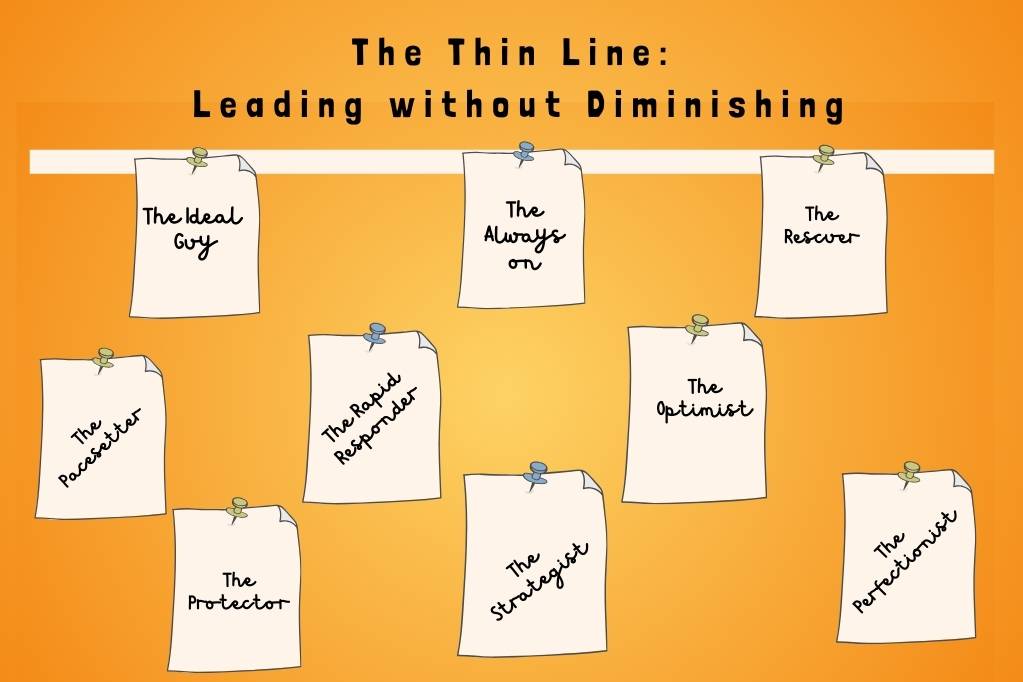Table of Contents
ToggleJust like a vine overshadowing a sprout, well-intentioned leaders can inadvertently hinder their team’s growth and autonomy, becoming unintentional barriers to success. In Liz Wiseman’s “social,” these leaders are identified as Accidental Diminishers. Dive into the third installment of our Multiplier (by Liz Wiseman’s book) series for insights on avoiding this common pitfall. Find our first two articles from our Multiplier book series here: Book Review: Insights into Multipliers and Evolving Towards Being a Multiplier Leader.
Accidental Diminishers and Their Many Faces
Accidental Diminishers come in various forms, each distinct in how they unintentionally shadow the potential of those they lead. Gain insight into their manifestations in the workplace and everyday situations.
The Idea Guy

Excitement for innovation is the hallmark of The Idea Guy. They provide their ideas hoping that it will trigger others to contribute their ideas as well. Instead, this leads others to shut down and curl up. As an agile coach, I often see top leaders unknowingly overshadowing their team's voices. A true leader encourages diverse perspectives and empowers their team to explore different angles. Instead of always being the first person to share an idea, try fostering a culture of shared decision-making through collaborative brainstorming sessions where everyone has a voice and ownership in the process.
The Always on

The Always on are always engaged. They bring brilliance and a rigorous presence to the room, spilling out a continuous stream of energy with hopes that others follow. Yet, their very brilliance often overshadows others, filling the room until there's little air left for others to breathe their own creativity. Effective workplace leaders maintain high engagement by being accessible to their teams at all times. While their intentions are good, this constant availability, such as responding to emails at 1am, or promoting your own availability without any offline/downtime hours, can inadvertently create pressure for team members to match the leader's schedule. This may result in sacrificing personal time, ultimately leading to burnout if sustained long-term.
The Rescuer

With the noblest of intentions, The Rescuer abhors the sight of struggle or failure in their teammates. Yet, it is through these very struggles that growth takes root. By swooping in prematurely, this leader ensures their team's wings remain underdeveloped, and they are unable to truly soar to heights of their true potential. Imagine a parent always stepping in to assist their child, like picking them up when they stumble or giving them the answers to their homework. My child’s algebra teacher once suggested a different approach to parents. Rather than just giving the solution to algebra problems, ask your child about their understanding of the problem, brainstorm ideas together, and explore potential solutions. This strategy fosters problem-solving skills that are crucial not only in math but also in future careers. Encourage independence and critical thinking for long-term success!
The Pacesetter

The one exemplifying the organization's values and setting the standard of achievement often sprints ahead, believing they accelerate progress. However, The Pacesetter may not see the team lagging behind, breathless and struggling to keep up, reduced to mere spectators in a race they once ran together. In “Multipliers", Wiseman shares her own experience as an unintentional diminishing leader with her own son. She used to have short sprinting races with him. On some occasions, she would dash off with her adult pace and be ahead, but only to find out that her son had quit trying early on. By understanding the importance of setting the right pace for your team, leaders can prevent demotivation and foster growth effectively.
Note to those dealing with Accidental Diminishing leaders: Transforming by Understanding and Collaborating
Encountering an Accidental Diminisher is not an end; rather, it is an opportunity veiled as a challenge—a chance to transform interaction into a positive one. Rather than harboring judgment or confrontations, foster cooperation. When diminishing behavior surfaces, empower yourself by choosing your response wisely.
- Embrace curiosity as your guiding light: Resist the temptation to vent frustration or give up entirely. Recognize that Diminishers often have no idea of their impact.
- Reconstructing Perceptions: seek to understand their point of view and employ active listening, thus opening doors for communication rather than confrontation.
- Embrace potential outcomes: Show trust, and respect, and leave room for individual expression in their reactions and the time for the leader to adjust their behavior based on feedback from you and/or the team.
The Rapid Responder

Valuing agility and swift action, The Rapid Responder jumps on challenges, troubleshooting with speed. Sadly, this can lull the team into a sense of lethargy, trusting that 'someone is on it', thus depriving them of the initiative to act. Take this scenario as an example: whenever a problem or issue is brought up, the more senior team members immediately provide a solution or explanation. This does not necessarily help create organizational capability/growth because the more junior team members are not challenged or triggered to analyze and come up with their own ideas to solve or explore the problem. It creates a reliance on the senior team members, who tend to become bottlenecks because the team ends up relying on their expertise. For leaders or more senior team members, it is ok to allow for those awkward silences in a team discussion. This gives the more junior team members, or people other than the leader, to digest the information and formulate their own thoughts.
The Optimist

Valuing agility and swift action, The Rapid Responder jumps on challenges, troubleshooting with speed. Sadly, this can lull the team into a sense of lethargy, trusting that 'someone is on it', thus depriving them of the initiative to act. Take this scenario as an example: whenever a problem or issue is brought up, the more senior team members immediately provide a solution or explanation. This does not necessarily help create organizational capability/growth because the more junior team members are not challenged or triggered to analyze and come up with their own ideas to solve or explore the problem. It creates a reliance on the senior team members, who tend to become bottlenecks because the team ends up relying on their expertise. For leaders or more senior team members, it is ok to allow for those awkward silences in a team discussion. This gives the more junior team members, or people other than the leader, to digest the information and formulate their own thoughts.
The Protector

Safety is the primary concern of The Protector, shielding their team from the harsh political winds. In the shelter of their benevolence, team members remain fledglings, never learning to withstand the storms on their own. I had once experienced the downside of having a well-meaning Protector manager. When that manager, who had expertly shielded me from the internal complexities and challenges of our organization, suddenly left, I was thrust into the fray with little preparation for what was to come. This abrupt transition left me unprepared for the realities of leading within a complex and bureaucratic organization. At one point, I thought to myself: “What did I get myself into?” The experience was a hard-earned lesson in the importance of broader organizational awareness and adaptability, serving as a good reminder of the delicate balance between protection and preparation in leadership.
The Strategist

Bold visions and compelling reasons to evolve are the fortes of The Strategist, whose plans shimmer with promise. Yet, sometimes, this leaves team members on the sidelines, second-guessing rather than proactively spearheading change. Meet Eddy, the powerhouse behind her organization's Digital Transformation (DT) initiative. Under immense pressure to accelerate the Time-to-Market process for software delivery, he took charge and orchestrated the entire strategy himself. To execute the strategy, Eddy assigned tasks and activities to the teams thinking that it will move the process faster. As the sole decision-maker for all activities within the DT initiative, when Eddy was away or unavailable to answer questions, the initiative came to a halt as the team awaited his return.
The Pefectionist

Lastly, The Perfectionist aspires to refine their team's output to flawless gleams but may inadvertently rub away their confidence. The crushing weight of constant critique can drain motivation, leading to a hesitancy to try. Everyone has the intention of doing a good job. On some occasion leaders can go as little overboard in providing feedback to the point of dictating or nitpicking: focusing on a report’s insight than worrying about the color of the charts, always incorporating a critique on the teams’ outcome, asking the team to incorporate your thoughts as what you think is the only standard for’what good looks like’. This can dampen the team’s enthusiasm and confidence, which discourages initiative and taking risks.
Unlock Your Potential: The Path to Empowering Leadership
Becoming a great leader is an ongoing journey of growth and development. It’s crucial to be aware of how your actions can inadvertently impact those around you. Strive to be a catalyst for intelligence and capability within your team. True leadership isn’t about hogging the limelight; it’s about shining it on others, helping them reach their full potential. It is your responsibility to ensure that your actions inspire, uplift, and empower others instead of stunting their growth.
The key lies in awareness. Seek feedback from others to gain insight into how your leadership style is perceived. Create a culture where team members feel comfortable providing feedback through various channels, including anonymously. By cultivating awareness and making a conscious effort, you can avoid, if not eliminate, accidental diminishing behaviors and foster an environment where everyone feels empowered and amplified.
Here’s to a future filled with impactful leaders, thriving teams, and positive change in the world.
Join the Movement:
- Does your organization have a feedback system in place?
- How do you ensure all voices are heard without fear of reprisal?
- What steps are you taking to continually improve as a leader?
Together, let’s embark on this empowering journey towards transformative leadership.
